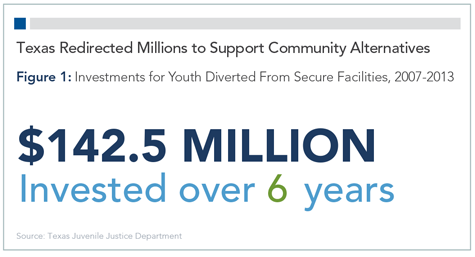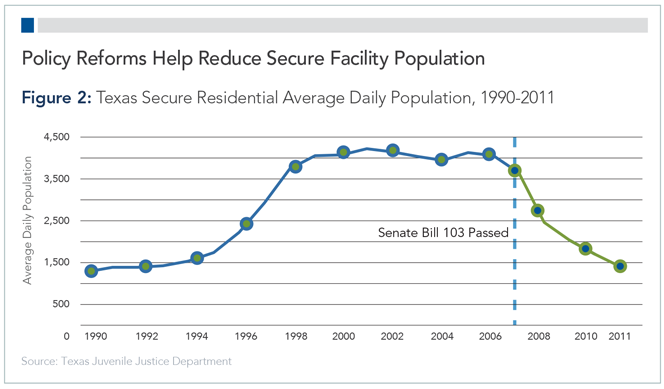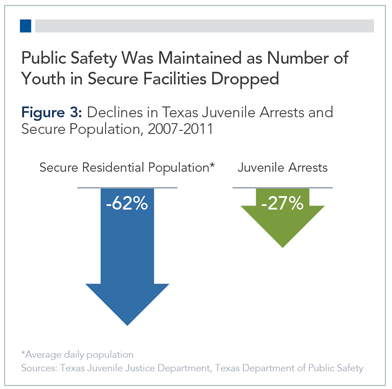Bending the Curve: Juvenile Corrections Reform in Texas
QUICK SUMMARY
During the past six years, Texas overhauled its juvenile corrections system, enacting a series of reforms that led to a significant reduction in the state-level committed population and yielded millions of dollars in cost savings while protecting public safety.
Problem
During the 1980s and 1990s, Texas responded to an increase in juvenile arrests with stiffer penalties for juvenile offenders. Those changes, coupled with expanded funding for secure state facilities, led to a near-tripling of the number of committed youth between 1993 and 2001.1
To accommodate this growth, Texas built one of the nation's largest juvenile corrections facilities, with planned capacity of more than 600 beds, in the early 2000s.2 In 2007, abuse was exposed in several secure state facilities, prompting a comprehensive juvenile corrections reform effort in the state.3
Reforms
Beginning in 2007, Texas took a series of steps to overhaul its juvenile corrections system, with a focus on encouraging local, evidence-based supervision for low-level youth offenders in order to improve system efficiency and public safety while reducing costs.
- Authorizing legislation: In 2007, Senate Bill 103 mandated a comprehensive package of reforms, including a ban on committing juveniles to secure state facilities for misdemeanor offenses; a reduction in the maximum age of youth permitted in those facilities, from 21 to 19; and creation of a release review panel to ensure that youth are prepared to return to the community.4
- Redirected resources: In 2007, $57.8 million that would have been used to house juveniles adjudicated for misdemeanors in secure state facilities was redirected to the relevant counties to support local, evidence-based programs for offenders.5
- Incentive funding: In 2009, Texas created the Commitment Reduction Program, which provides grant funding to county probation departments that manage appropriate juvenile offenders locally, rather than committing them to secure state facilities.6 Programs funded through the grants must be cost-efficient and evidence-based and demonstrate reductions in recidivism in order to be eligible for renewed funding.7 Texas appropriated $45.7 million in 2009 and an additional $39 million in 2011 for the program.8

- Standardized tools: Texas also implemented a statewide, Web-based, validated assessment tool to assist judges in making disposition decisions by identifying the levels at which each youth is at risk for recidivism.9
- Streamlined system: In 2011, Senate Bill 653 created the Texas Juvenile Justice Department to streamline and integrate the residential functions of the Texas Youth Commission and the community-based programs of the Texas Juvenile Probation Commission.10 The legislation continued the reforms begun in 2007, prioritizing the development and use of evidence-based alternatives to commitment to state facilities.
Impact
The reforms of the past six years contributed to a significant reduction in the committed juvenile population and helped Texas save substantial funds while boosting public safety.
- Commitments down: The number of new admissions to state facilities fell 59 percent between fiscal 2007 and 2011, from more than 2,300 to 960.11
- During the same period, the percentage of dispositions resulting in commitment to state facilities was cut in half.12
- The average daily population in secure state youth facilities declined 62 percent, reducing the state's daily population to pre-1993 levels.13

- Costs reduced: Texas has closed or consolidated seven secure state facilities since 2008, saving the state more than $50 million annually.14
- Public safety maintained: Arrest trends and a recent analysis of reoffending by the Texas Legislative Budget Board suggest that the reforms have helped boost public safety.
- Statewide juvenile arrests dropped 27 percent between 2007 and 2011.15
- There has been a slight decrease in the recidivism rate of youth on probation. While 13.4 percent of youth placed on probation in 2007 were incarcerated within three years, that rate fell to 12.3 percent for those placed on probation in 2009.16
- Three-year reincarceration rates for juveniles released from secure state facilities in 2009 remained at the historical average of about 47 percent.17 This is an improvement because the shift to community programs of juveniles adjudicated for less serious offenses means the facilities are managing a more violent population.

ENDNOTES
1 Data provided by the Texas Juvenile Justice Department (July 2012).
2 Texas Youth Commission, Annual Report (FY2002), http://www.tjjd.texas.gov/archive/annual_rpt02/section2/p12_construction.html.
3 See, for example, Nate Blakeslee "Hidden in Plain Sight," Texas Observer (Feb. 23, 2007); and Ralph Blumenthal "Citing Abuses, Texas Governor Ousts Leader of Youth Agency," The New York Times (Feb. 23, 2007).
4 Senate Bill 103. http://www.legis.state.tx.us/billlookup/text.aspx?LegSess=80R&Bill=SB103
5 Texas Juvenile Probation Commission Annual Report to the Governor and Legislative Budget Board. Juvenile Probation Appropriations, Riders and Special Diversion Programs, p. 38 (December 2011), http://www.tjjd.texas.gov/publications/reports/RPTOTH201202.pdf.
6 Texas Administrative Code, Title 37, Part 11, Chapter 346, Subchapter B, Rule §346.202, http://info.sos.state.tx.us/pls/pub/readtac$ext.TacPage?sl=R&app=9&p_dir=&p_rloc=&p_tloc=&p_ploc=&pg=1&p_tac=&ti=37&pt=11&ch=346&rl=202. Note, the Commitment Reduction Program is also known as Grant C–Community Corrections Diversion Program. See, for example, http://www.house.state.tx.us/_media/pdf/committees/reports/81interim/House-Committee-on-Corrections-Interim-Report-2010.pdf. The summary of grant requirements is available online: http://www.tjjd.texas.gov/publications/standards/Grants12/TJPCGRANTSC.pdf.
7 Texas Juvenile Justice Department Commitment Grant C–Commitment Reduction Program Compliance Resource Manual, http://www.tjjd.texas.gov/publications/standards/Grants12/TJPCGRANTSCCRM.pdf.
8 Texas Juvenile Justice Department Annual Report to the Governor and Legislative Budget Board (December 2012), Community Juvenile Justice Appropriations, Riders and Special Diversion Programs, http://www.tjjd.texas.gov/publications/reports/AnnualReportFundingandRiders2012-12.pdf.
9 Texas Juvenile Probation Commission (2010), The risk and needs assessment tool: What statewide data reveal. PowerPoint presentation at the 2010 Data Coordinators Conference, Austin. http://www.tjjd.texas.gov/statistics/2010DataCoordConf/RiskAndNeedsAssessmentTool.pdf.
10 Senate Bill 653. legis.state.tx.us/billlookup/Text.aspx?LegSess=82R&Bill=SB653. Texas Juvenile Justice Department website: http://www.tjjd.texas.gov/
11 Texas Juvenile Justice Department (2012), Strategic Plan 2013-2017. Austin, TX. http://www.tjjd.texas.gov/publications/reports/TJJD%20Strategic%20Plan%20-%20FINAL%20-%20JULY%202012.pdf.
12 Ibid.
13 Data provided by the Texas Juvenile Justice Department (July 2012).
14 Sheffield (2008), McLennan (two-unit consolidation, 2011), Victory Field (2010), West Texas State School (2010), Crockett (2011), Ron Jackson Unit II (2011), and Al Price (2011). Texas Juvenile Justice Department communication.
15 Texas Department of Public Safety's Annual Report of 2011 UCR Data Collection: Crime in Texas 2011 Overview (p. 2) http://www.txdps.state.tx.us/director_staff/public_information/2011CIT.pdf.
16 Texas Legislative Budget Board, Statewide Criminal and Juvenile Recidivism and Revocation Rates (January 2013). http://www.lbb.state.tx.us/Public_Safety_Criminal_Justice/RecRev_Rates/Statewide%20Criminal%20Justice%20Recidivism%20and%20Revocation%20Rates2012.pdf.
17 Ibid.











